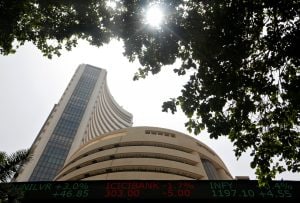FY18 annual report analyses: Brokers expect these 11 stocks to give 14-100% return

KV Prasad Jun 13, 2022, 06:35 AM IST (Published)
 Listen to the Article (6 Minutes)
Listen to the Article (6 Minutes)
Summary
The carnage in midcap and smallcap stocks is a buying opportunity in select stocks where earnings growth is fair and the outlook is strong.
Indian markets, represented by the Sensex and Nifty, have scaled fresh record highs even as the broader market, comprising of mid and small caps, are witnessing a correction.
The mid and small cap indices have plunged nearly 15 percent and 18 percent this year, after rising 48 percent and 60 percent respectively last year.
The carnage in midcap and smallcap stocks is a buying opportunity in select stocks where earnings growth is fair and the outlook is strong, Mahesh Patil, co-chief investment officer and fund manager, Aditya Birla Sun Life AMC told CNBC-TV18.
Rajeev Srivastava, head-retail broking, Reliance Securities, said that the ongoing Q1 earnings season is unlikely to disappoint but said valuations aren’t cheap. “Therefore, one needs to be careful while treading in the current market. Getting carried away becomes easy when one sees stocks especially in the mid and small cap space.”
It would be advisable to stick to fundamentals and invest in stocks of quality companies which are generating positive cash flows rather than getting trapped in penny stocks, he added.
Siddharth Sedani of Anand Rathi Shares and Stock Brokers said results will be closely watched – for support in mid & small cap stocks. “Along with this, good monsoon (widespread and adequate rainfall) will be crucial in containing inflation, boosting earnings growth and shoring up rural demand.”
Here is the list of 11 stocks that can give 14 to 100 percent returns:
Brokerage: Dolat Capital
NCC: Buy | Target: 164 | Return: 100%
NCC standalone received historic high order inflow of Rs 24,700 crore in FY18 which is more than 3x received in FY16 (Rs 7,400 crore) / FY17 (Rs 7,700 crore). This lead to highest ever standalone order book of Rs 29,990 crore providing robust 4x FY18 revenue visibility. around 92 percent of FY18 order inflow is in its core segments (‘buildings & roads’ and ‘water’) and compression of execution timeline to 12-24 months will drive growth.
NCC plans to shut down its unviable international operations in the next 6-12 months which will strengthen the balance sheet and any monetization of real estate will aid deleveraging.
We expect NCC to witness robust revenue growth supported by highest ever order inflow and order book having shorter execution timeline, decent EBITDA margin, healthy profit growth, improvement in working capital limiting debt and interest cost, declining leverage over FY18-20E. It continues to focus on core construction business and deleveraging balance sheet, particularly through the sale of land.
Thus, we maintain Buy on the stock with SOTP (sum-of-the-part) based target price of Rs 164.
Balkrishna Industries: Buy | Target: Rs 1,356 | Return: 18%
Balkrishna Industries has rapidly progressed as a global player in the off-highway tyres (OHT) segment and with lot of headroom available on distribution front, we expect BKT to grow at more than double the industry growth rate.
Margins will further improve due to backward integration and with no major capex in coming 2-3 years, return ratios will expand.
Despite the outperformance in the stock price, we believe that BKT is a structural bet and should be accumulated at all dips. Recommend Accumulate with a target price of Rs 1,356.
Persistent Systems: Buy | Target: Rs 1,200 | Return: 44%
We expect Persistent Systems to report revenue growth of 13 percent USD terms in FY19 as compared to 9.7 percent in FY18 which is higher than peers and industry averages helped better revenue growth in the Enterprise vertical.
Persistent expects double digit growth in IBM Watson which will drive better growth in Alliance segment. We expect margin improvement led by lower R&D and better growth in enterprise.
The company is already trading at inexpensive valuation of 14x/11.7x based on FY19E/FY20E earnings estimate.
We believe consistent revenue growth coupled with improvement in margin may trigger upgrades in the near term. We maintain Buy rating with target price of Rs 1,200 based on 15.5x one year forward PER.
Dixon Technologies: Buy | Target: Rs 3,430 | Return: 20%
Company added new customers in last year in all its verticals, with big brands like Samsung, Flipkart, Crompton, Lloyds etc. as its customer.
Dixon is confident about expanding margins. It will also be helped by more backward integration. It continues to talk to many big brands in TVs and mobile and expects to add more clients in FY19.
Company increased its cash to Rs 44.1 crore from Rs 15.4 crore following its IPO. Cash flow from operations was higher at Rs 117.3 crore compared to Rs 82.7 crore in last year. Company did major capex of Rs 71.2 crore for setting up its plant at Tirupati. Capex in FY17 was Rs 26.1 crore. Further capex of Rs 40 crore is expected to be incurred in FY19 for Tirupati facility expansion. Company repaid debt of Rs 22 crore during the year.
We expect TV and washing machine volumes to drive growth for Dixon in FY19. We have an Accumulate rating for the stock with a target price of Rs 3,430, valuing stock at 33x for FY20 EPS.
KEC International: Buy | Target: Rs 390 | Return: 19%
FY18 was a strong year despite facing challenges regarding GST implementation in first half of FY18 with revenue at Rs 10,090 crore grew by 15.3 percent YoY as EBIDTA grew by 23 percent to around Rs 1,000 crore and PAT grew by 1.5x to Rs 460 crore. Overall order book was up 37 percent given the strong capex environment in power transmission and rail electrification projects.
Management has guided for a 15 percent revenue growth in FY19, which we believe is doable.
The management expects to double its revenues from railway segment with margins moving closer to T&D. There is focus on reducing interest cost and debt along with better working capital management.
We see 16 percent revenue CAGR over FY18-20E. We maintain Accumulate rating with target price Rs 390 based on target multiple of 15xFY20E.
ITC: Buy | Target: Rs 310 | Return: 16%
Despite a sharp slowdown in the economy, steep increase in tax incidence on cigarettes, subdued demand conditions in the FMCG industry, shortage of tobacco crop in Andhra Pradesh and lack of trading opportunities in the Agri Business, ITC witnessed satisfactory performance in FY18.
While net sales grew by just over 1 percent, bottomline grew by 6 percent during the year.
Cigarette volume growth is expected to amplify on the favourable base of past one year (around 18 percent volume decline in past three years).
Packaged food business, which accounts for 76 percent of ITC’s non-cigarette FMCG business is expected to drive growth.
Moreover, normal monsoon forecast and increasing disposable income, we anticipate consumer shift from bidi to cigarette as well as to branded FMCG products which is likely to improve company’s profitability. Maintain Accumulate.
Havells India: Buy | Target: Rs 640 | Return: 14%
In the Annual Report, Havells has discussed at length the impact of automation and software solutions across its entire value chain. It has also outlined some of the future initiatives it has planned to use IoT, Big data etc.
We are very enthused about the way the company has utilised and continues to use IT as a major business enabler.
From a commercial angle, this has helped Havells in saving significant manpower cost incurred previously to manage the loyalty programmes and reduce retail last mile workforce by 50 percent.
FY18 saw business stabilizing post GST and improved after rates for most of the durables came down to 18 percent from 28 percent in November 2017.Havells is seeing a shift of unorganised to organised.
Channel expansion is the Havells key strategic initiative involves greater engagement with the retailers, exclusive brand store online platform with continuity of relationships with its distributor and direct dealers.
We continue to like Havells in the consumer electricals space. Structural growth story should continue, and we maintain Buy rating.
Brokerage: Stewart & Mackertich Wealth Management
Everest Industries: Buy | Target: Rs 566 | Return: 45%
Everest Industries (EIL) is the pioneer of fiber cement products in India. In the pre-engineered steel buildings (PEB) segment, the company is seating with the order book of 32,000 tonnes in value term which is Rs 300 crore.
Positive cash flows due to improved receivable and working capital management have resulted in the ability to minimise borrowings. Debt Equity ratio improved from 0.27 as at FY17 to 0.13 as at FY18 while the interest coverage ratio improved from 1.3 to 6.9 during the year.
We reduced target price to Rs 566 from Rs 669 by using DCF methods, keeping in mind the robust demand for building products, and their strong participation in ‘Bharatmala Project’, & ‘Housing for all by 2022’, however, subdued PEB segment due to volatile steel price could erode the blended margin.
We believe in the coming year they could ramp up their steel building segment margin which will push their bottom line.
Thermax: Buy | Target: Rs 1,420 | Return: 38%
Thermax Limited provides a range of engineering solutions to the energy, cement, oil & gas, chemical, metal and environment sectors.
Company’s key strategy has been to protect its business from cyclicality of the India’s capital goods sector. Through selective internationalisation of the product businesses and strategic expansion of its product manufacturing footprint, the company has progressed well in this direction.
With the help of its new capacities, company is well positioned to benefit from domestic and global demand recovery and expected to generate positive cash flow in future.
Its presence in areas like clean and green technology gives traction for the long term outlook. With the significant capex coming over, the company is looking at significant growth in its businesses along with improving profitability.
Thermax Group posted a significantly higher order booking for FY2017-18 at Rs 6,380 crore, a 45.2 percent growth over the previous fiscal. It won the highest ever export contract of $157 million from a leading African conglomerate for its refinery project coming up in Nigeria.
Brokerage: Motilal Oswal
Emami: Buy | Target: Rs 690 | Return: 25%
Emami (HMN) HMN is transforming itself to stay ahead of industry with a continuing high focus on innovation and advertisements. Increased emphasis on data analytics – an area where it had lagged peers previously – is a welcome move. ‘Naya Emami’ seems to be the rallying cry.
The stock has been an underperformer over the past two years, which is not surprising, as absolute PAT declined by 4 percent over this period compared to 18 percent CAGR over the preceding five years. Earnings recovery will also be gradual, as HMN is likely to witness the impact of weak summer sales on its talcum powder and cooling oils businesses in 1QFY19.
Nevertheless, we remain convinced about HMN’s strong medium- to long-term revenue and earnings growth prospects as ongoing distribution expansion, continued high pace of innovation, problem-solving nature of its products, high advertisements, and importantly a normalised environment (unlike FY17 and FY18) lead to resumption of strong revenue growth both in the core portfolio and new launches.
At 29.5x FY20E EPS, HMN is inexpensive relative to peers, particularly given its healthy long-term earnings growth opportunity and mid-30s return ratios. Our target price is Rs 690. Maintain Buy.
Brokerage: Reliance Securities
Shree Cement: Buy | Target: Rs 21,500 | Return: 33%
While there has been an increase in debt balance led by new capacities, Debt/Equity at 0.1x and healthy operating cash flow (OCF) generation (Rs 1,880 crore) continue to remain impressive.
Further, low contingent liabilities and continued thrust on growth bode well. We expect its premium multiple to sustain, which can be supported by thin liquidity and meagre non-institutional holdings.
We have a Buy rating on the stock with a target price of Rs 21,500.
Disclaimer: The views and investment tips expressed by investment experts are their own and not that of the website or its management. Users are advised to check with certified experts before taking any investment decisions.
Source: Moneycontrol.com

Elon Musk forms several ‘X Holdings’ companies to fund potential Twitter buyout
3 Mins Read
Thursday’s filing dispelled some doubts, though Musk still has work to do. He and his advisers will spend the coming days vetting potential investors for the equity portion of his offer, according to people familiar with the matter

KV Prasad Journo follow politics, process in Parliament and US Congress. Former Congressional APSA-Fulbright Fellow










 Listen to the Article
Listen to the Article  Daily Newsletter
Daily Newsletter













